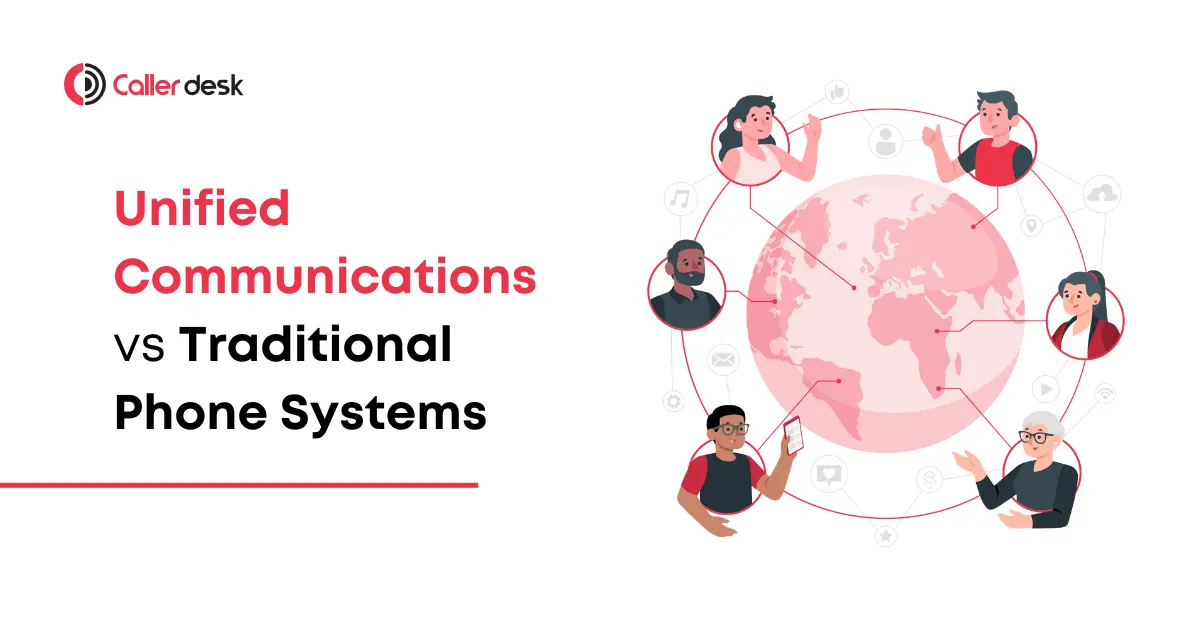When it comes to setting up your business communication infrastructure, you’re likely faced with a critical decision: unified communications (UC) or a traditional phone system? The right communication system plays a pivotal role in ensuring smooth operations, better collaboration, and supporting business growth.
While both options have their merits, they also come with distinct advantages and limitations. This guide breaks down the differences between unified communications (UC) and traditional phone systems, helping you make an informed decision based on your business needs.
Traditional Phone System
Also known as Private Branch Exchange (PBX) systems, traditional phone setups have long been the go-to communication solution for businesses. These systems rely on physical hardware and telephone lines, offering a basic yet reliable platform for voice communication.
Key Benefits of Traditional Phone Systems
- Reliability: Traditional PBX systems are well-established and rarely suffer from outages or connectivity issues, making them a reliable option for businesses that prioritize uptime.
- Ease of Use: Most employees are familiar with traditional systems, and they tend to have a straightforward, hands-on setup.
- Security: Being a closed-circuit system, PBX is often seen as more secure, particularly when it comes to data transmission over voice channels.
Drawbacks of Traditional Phone Systems
- Limited Features: Traditional phone systems typically only support voice calls and lack integration with other digital tools, such as video conferencing, team messaging, or file sharing.
- High Costs: The setup and ongoing maintenance of hardware can be expensive, especially as your business grows or requires upgrades.
- Scalability Issues: Expanding a traditional phone system often requires significant investment in new physical hardware, which can be both costly and time-consuming.
Unified Communications
Unified Communications (UC) integrates voice, video, messaging, file sharing, and other communication tools into a single platform. Typically cloud-based, UC systems allow employees to collaborate seamlessly across multiple devices—whether they’re in the office or working remotely.
Key Benefits of Unified Communications
- Enhanced Collaboration: UC platforms provide real-time communication through voice, video, chat, and file sharing, making team collaboration more efficient and effective.
- Flexibility and Mobility: UC systems are accessible from any internet-connected device, enabling employees to work from anywhere, whether at the office, at home, or on the go.
- Cost-Efficient Scaling: Adding new users or upgrading features can be done via software adjustments, reducing the need for additional physical infrastructure.
Drawbacks of Unified Communications
- Dependency on Internet: UC systems rely on a stable internet connection, so communication quality may suffer during network disruptions.
- Learning Curve: While UC platforms offer advanced features, they may take some time for employees to learn and adapt to the new tools and interfaces.
- Data Security: Since UC platforms are cloud-based, they require strong security measures to protect sensitive data exchanged across digital channels.
How Do Unified Communications and Traditional Phone System Compare?
Now that we’ve outlined the benefits and drawbacks of both systems, let’s take a closer look at how they stack up against each other based on key business needs:
1. Flexibility and Mobility
Unified Communications excels in providing a flexible, mobile-friendly environment, where employees can seamlessly switch between devices and access communication tools from anywhere. Whether it’s video conferencing, instant messaging, or file sharing, all of it is available at the click of a button.
On the other hand, traditional phone systems are often limited to voice calls and are generally restricted to on-site usage. This can be a significant drawback for businesses that prioritize remote work and mobility.
2. Scalability
When it comes to scalability, UC systems shine. They can easily scale up or down without requiring extensive hardware upgrades—simply by adjusting software settings. For growing businesses, this cost-effective scalability makes UC the ideal choice.
In contrast, traditional phone systems require hardware upgrades when expanding. Each new employee or department usually requires new phone lines and equipment, which can be expensive and time-consuming to implement.
3. Cost Efficiency
UC systems typically come with lower initial setup costs, particularly when using cloud-based platforms. With minimal hardware investment and software-based scaling, these systems offer ongoing cost savings compared to traditional systems.
On the other hand, traditional systems tend to have higher initial and maintenance costs, especially if you need to upgrade hardware or expand the system to accommodate new users.
4. Reliability
Traditional phone systems are known for their dependability—they aren’t affected by internet issues, ensuring uninterrupted voice communication. However, this comes at the cost of flexibility and modern features.
While UC systems do rely on a stable internet connection, many providers now offer backup solutions to maintain service during network disruptions. This can reduce the risks typically associated with internet dependency.
5. Integration with Other Tools
UC platforms are designed to integrate seamlessly with a wide range of digital tools like CRM systems, project management software, and collaboration platforms. This makes it easier to streamline workflows and improve team productivity.
In contrast, traditional phone systems generally don’t support these integrations, which can create inefficiencies in a modern, tech-driven workplace.
Which System Is Right for Your Business?
Choosing between unified communications and traditional phone systems depends on your business’s goals, budget, and growth plans. Here are some things to consider:
- Flexibility & Mobility: If your business requires remote work and flexible communication options, UC is the clear winner. If you prioritize traditional, on-site communication, PBX may still be sufficient.
- Scalability: Growing businesses will benefit from the ease of scaling that UC systems offer, whereas traditional phone systems can quickly become cumbersome as you expand.
- Cost Efficiency: If you’re looking for a cost-effective solution, UC’s lower initial costs and minimal maintenance make it the more affordable option.
- Reliability: If uptime and dependability are non-negotiable, traditional phone systems are hard to beat. However, UC systems with backup options are also a reliable choice.
- Integration Needs: If you require seamless integration with other tools like CRMs or team collaboration platforms, UC systems are better equipped to handle those needs.
Conclusion:
When choosing between unified communications (UC) and traditional phone systems, it’s important to weigh your business’s current needs and future plans. UC systems offer superior flexibility, scalability, and cost efficiency, making them ideal for growing, tech-savvy businesses. However, traditional phone systems may still be a good fit for organizations that prioritize stability and simplicity.
Ultimately, the right communication system will keep your team connected, efficient, and ready to meet your business objectives.
Also read this: Why Every Business Needs a Cloud-Based Business Phone System





